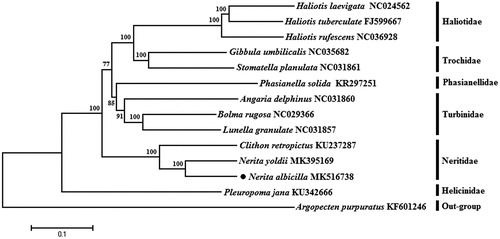Abstract
The complete mitochondrial genome of Nerita albicilla was determined. The mitochondrial genome is 15,314 bp in length, comprising two ribosomal RNA (12S and 16S) genes, 13 protein-coding genes, and 22 transfer RNA genes. Of these 37 genes identified, seven protein-coding genes, and eight transfer RNA genes are encoded on the heavy strand and the other genes on the light strand. This gene order is consistent with the previously published mitochondrial genomes of the other neritid species. The length of 22 tRNAs ranges from 65 bp to 73 bp and the overall base composition is 14.9% of C, 20.7% of G, 34.0% of T, and 30.5% of A. The phylogenetic tree was constructed based on 13 protein-coding genes of N. albicilla and other 13 Archaeogastropoda species, Argopecten purpuratus as outgroup using the Neighbor-joining method, the tree showed that N. albicilla is most closely related to the Nerita yoldii. We believe that this result will further supplement the genome information in mitochondria of the family Neritidae and facilitate the study on population genetic.
Nerita albicilla (Linnaeus, 1758), common name the blotched nerite, is a species of sea snail, a marine gastropod mollusk in the family Neritidae. It is distributed throughout the coastal waters of the Indo-Pacific region. Nerita albicilla is found on rocks, breakwaters, and seawalls in lower to middle intertidal zone (Tan and Clements Citation2008). It has a shell length of 20–30 mm, operculum thick and flattened oval. The surface is smooth or with slight transverse ridges. Its outer shell color is variegated black and white, occasionally with three conspicuous bands. Small ridged teeth on the straight edge at the shell opening (Sasaki Citation2001). This gastropod is an important and commercially exploited species.
This is the first report of a complete mitochondrial genome sequence for N. albicilla, a marine gastropod mollusk in the family Neritidae. The specimen of N. albicilla was collected in Haikou, Hainan province, China (110.2°E, 20.1°N). Samples were identified by experienced fisheries researchers from Zhengjiang Ocean University and stored in Specimen Room of national engineering research center for marine aquaculture. The total DNA extraction was utilized the salting-out method (Aljanabi and Martinez Citation1997) with the muscle. The genomic DNA was prepared in 400 bp paired-end libraries, and sequenced the mitochondrial genome on Illumina HiSeq X Ten platform using the total genomic DNA. The annotated mitogenome of N. albicilla has been deposited into GenBank database (GenBank accession number MK516738).
The mitochondrial genome is 15,314bp in length, comprising two ribosomal RNA (12S and 16S) genes, 13 protein-coding genes and 22 transfer RNA genes. Of these 37 genes identified, seven protein-coding genes, and eighttransfer RNA genes are encoded on the heavy strand and the other genes on the light strand. This gene order is consistent with the previously published mitochondrial genomes of the other neritid species (Arquez et al. Citation2014; Uribe et al. Citation2016). The 16S and 12S genes are located between tRNALeu and tRNAMet, with respective lengths of 1370 bp and 873 bp. In 13 protein-coding genes, the nad4l gene starts with ATA, the other genes start with ATT or ATG, and TAA or TAG as the stop codon. The length of 22 tRNAs ranges from 65 bp to 73 bp and the overall base composition is 14.9% of C, 20.7% of G, 34.0% of T, and 30.5% of A. shows the phylogenetic position of N. albicilla based on the present and previous mitogenome data.
Figure 1. The NJ phylogenetic tree for Nerita albicilla and other species based on 13 protein-coding genes. The black dot indicated the species in this study. The number at each node is the bootstrap probability. The number after the species name is the GenBank accession number.

The phylogenetic tree was constructed based on 13 protein-coding genes of N. albicilla and other 13 Archaeogastropoda species, A. purpuratus as outgroup using the Neighbor-joining method (Saitou and Nei Citation1987), the tree showed that N. albicilla is most closely related to the N. yoldii. We expect the present results will further supplement the genome information in mitochondria of the family Neritidae and facilitate the study on the taxonomy, population genetic structure and phylogenetic relationships.
Disclosure statement
The authors report no conflicts of interest. The authors alone are responsible for the content and writing of the paper.
Additional information
Funding
References
- Aljanabi SM, Martinez I. 1997. Universal and rapid salt-extraction of high quality genomic DNA for PCR-based techniques. Nucleic Acids Res. 25:4692–4693.
- Arquez M, Colgan D, Castro LR. 2014. Sequence and comparison of mitochondrial genomes in the genus Nerita (Gastropoda: Neritimorpha: Neritidae) and phylogenetic considerations among gastropods. Mar Genomics. 15:45–54.
- Saitou N, Nei M. 1987. The Neighbor-joining method: a new method for reconstructing phylogenetic trees. Mol Biol Evol. 4:406–425.
- Sasaki T. 2001. Macro- and microstructure of shell and operculum in two Recent gastropod species, Nerita (Theliostyla) albicilla and Cinnalepeta pulchella (Neritopsina: Neritoidea). Paleontol Res. 5:21–31.
- Tan SK, Clements R. 2008. Taxonomy and distribution of the Neritidae (Mollusca: Gastropoda) in Singapore. Zool Stud. 47:481–494.
- Uribe JE, Colgan D, Castro LR, Kano Y, Zardoya R. 2016. Phylogenetic relationships among superfamilies of Neritimorpha (Mollusca: Gastropoda). Mol Phylogenet Evol. 104:21–31.
